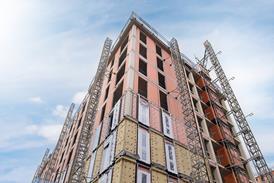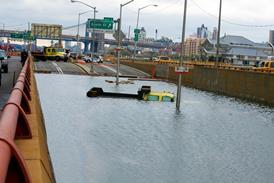Instead the boggy building site in Addlestone was a model of cleanliness. Not a mucky boot in sight. Wates project manager Jim Watts, who oversaw the transformation, even claims that "sites need not be muddy anymore".
The secret? Soil stabilisation: mixing cement and/or lime with a soil to improve its engineering characteristics. It's been used on road jobs for years, and is reasonably commonplace on warehouse projects. But it's just coming into its own on building jobs.
Lime stabilisation has been in the codes for road building since the mid '80s. In 1988 it was used on the M40 extension between Oxford and Birmingham, but just two years later a section of the road failed. There is some disagreement among experts as to whether the commonly cited cause of sulphate heave was to blame, but what that case did serve to highlight was the importance of thorough site investigation. Sulphates and lime react and heave.
Since then, soil stabilisation has been used increasingly on road projects and also for building jobs where large areas of ground are involved. Warehouse projects are the most common jobs for specialist contractor Geofirma. Director Jonathan Smith says many of these are on brownfield sites. Contamination hot spots go to landfill, but to do that with the remaining soil which contains low levels of pollutants would be expensive.
In 1997, contractor O'Keefe Soil Remediation changed the way cementitious materials are added to the soil which made the whole process a lot more environmentally acceptable and controllable. Previously lime and cement had been spread on the ground and churned in with a rotivator. No good in windy or wet weather. O'Keefe worked with plant manufacturer Wirtgen to adapt its massive WR 2500K, originally designed for breaking up roads, so that a computer-controlled hopper to deliver the lime or cement and the churning blades are all enclosed in a rubber skirt.
Rubber skirts & heavy metal
O'Keefe and its new machine – which other UK specialist contractors also now have - have worked on jobs like car parking for the Millennium Dome and Dartford and Gravesham PFI hospital. In 1999 it did a different type of contract at a PFI school in Leytonstone for Wates Construction. Here the mix of cement was designed to lock in heavy metals which polluted the site. This is called stabilisation/solidification but has not yet been used widely in the UK because of a lack of knowledge on its use [see below].
O'Keefe Soil Remediation's operations director Mark Jones sees potential growth in the market on jobs like the office development in Addlestone which it did for Wates. O'Keefe got that job because an estimator at Wates suggested soil stabilisation as an answer to the problem.
The attitude of developer Brixton, with which Wates negotiates work, was key. It was all about time and cost certainty. O'Keefe stabilised six acres, around half of the site, known as Aviator Park, of which Wates has built the first two buildings.
First it mixed lime into the mix of granular material, sand, gravel, mud and clinker to dry it out. Then the cement. The amount of cement added (and therefore the strengths achieved) varied according to the use. High strength was required for the footprints of the buildings to take the weight of piling rigs. Ditto for a 4m band around each building's perimeter to hold cherrypickers and scissor lifts for installing cladding and windows. Car parking areas and roads also got the treatment, with base course tarmac in place by week 12. "A good position to be in," says Watts.
True value
There were other benefits too. No more posts and strings for setting out. A circular diamond blade mounted on a Bobcat cut the setting out lines straight into the stabilised soil, saving an engineer's time. And O'Keefe's controlled-level dozer meant that redressing the levels on the car-parks pre-tarmacing was minimal.
On this job it was the client's attitude -that certainty is of higher value than cost -that made soil stabilisation a good solution. Watts thinks that the use of the technique will grow as more clients look for best value, and not lowest price. "If you just looked at the cost of stabilising , you wouldn't touch it. But if you take into account risk, programme certainty, cost of importing and exporting material and look at it properly, you can assess the true value to the project overall."
1 - Decide if your project could benefit. Is it
2 - Work out what you’ve got
Extensive site investigation is needed. Particularly look out for:3 - Do some trials
4 - Mix it in
5 - The chemical reaction
6 - Compact it
7 - Test it
Future applications: stabilisation/solidification
Adding cementitious materials to contaminated soils can lock in pollutants, and sometimes convert them into a less harmful form. This technique has been used widely in the US, and also in France, but so far in the UK its applications have been mostly experimental. Bachy Soletanche carried out the first in-situ stabilisation/solidification in 1995 on an ICI explosives site in Ardeer, Scotland. But the EC Land Directive comes into force in 2004, increasing the cost of sending contaminated soil to landfill. This could make stabilisation/ solidification (as well as other remediation) treatments more viable. “The major difficulty has been that it has been competing with cheap disposal to landfill,” says Dr Colin Hills of Greenwich University’s centre of contaminated land treatment. “You will go for the cheapest option and remove your problem. This is not sustainable and it is all going to change.” Dr Hills is principle investigator on a three-year project to produce Codes and Standards for Stabilisation/ Solidification Technology (CASSST) which is just coming to an end. There are three codes: definitive guidance for the Environment Agency, a report detailing the science behind it and a site guide for contractors on when stabilisation/solidification can be used, how it can be used and what sort of thing should be considered and monitored. Confusingly, stabilisation in this context means chemical stabilisation of the pollutants to make them less toxic or mobile (rather than in soil stabilisation, where it refers to increasing bearing strength). Solidification is the physical containment of contaminants within a solid product. Mixing in the cementitious materials using the same method as for soil stabilisation is just one of a number of techniques which fall under this classification. Others include mixing interlocking columns with augers to form a barrier and treating material ex-situ. The type of cementitious material used, such as lime, cement, pulverised fuel ash, ground granulated blastfurnace slag, together with other additives depends on the type of contaminants present in the ground. The draft final version of the site guide Construction Aspects of Stabilisation/Solidification for the Treatment of Contaminated Soils can be found on the CASSST website. Referenceswww.cassst.co.uk
The Stabilisation/solidification Treatment And Remediation Network www-starnet.eng.cam.ac.uk
Source
Construction Manager





















No comments yet